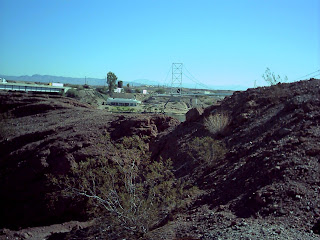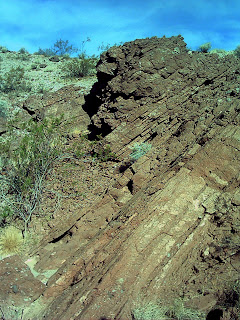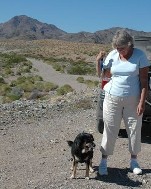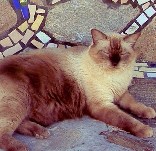Monday, September 24, 2007
Trip Sixteen
Route 66 in Baby Steps - Destination One
The Colorado River Crossing
 Home Sweet Home!
Home Sweet Home!
Catching I40 toward Topock, AZ. Exiting Park Moabi Road. At the San Bernardino County Park entrance turn right. Go as far as possible, under the freeway and to the Colorado River. Park and hike around. New blog will be updated, Hidden Places Along Route 66. Yippee!
 Destination One
Destination One
Here come the pics!






























Making postcards for Hidden Places Along Route 66. Check it out.
The Colorado River Crossing
 Home Sweet Home!
Home Sweet Home!Catching I40 toward Topock, AZ. Exiting Park Moabi Road. At the San Bernardino County Park entrance turn right. Go as far as possible, under the freeway and to the Colorado River. Park and hike around. New blog will be updated, Hidden Places Along Route 66. Yippee!
 Destination One
Destination OneHere come the pics!






























Making postcards for Hidden Places Along Route 66. Check it out.
Saturday, September 15, 2007
Can You Believe How Long It Has Been?
Yes, it has! Gaby and I have been stuck inside for ages and still no real let up in sight. There is always a forecast of cooler nights and mornings but it never happens. Gaby really suffers riding around, even with the air conditioner on in the truck. So we are waiting for some cooler mornings for little trips.
Been listening to Bob Moore's Route 66 Show on Bounce Radio on Friday evenings at 5 pm. (I'm going to add the radio button on the side bar.) So now we are anxious to start becoming Roadies-in-Training. We have some short trips planned to trace what we can find of Route 66 near and through Needles.
Also I mentioned to Hwyrovr, that's Bob Moore, how much I liked Robert Waldmire's art and he gave me a whole collection of his postcards. How cool! Thank you Bob! That got me thinking how I could memoralize my own trips on Route 66. That's how the idea was born for "Hidden Places Along Route 66" using the art techniques I learned in school and no work bigger than 4" x 6"! That last part is because of the social security budget and no art store in sight!
I'm knitting a bunch of scarves, see Finished It! I hope to have a little booth at the Needles Olde Fashioned Christmas Parade.
Note to Me: When we explore between Oatman and Kingman on Seligman Pass, I think, look for Ed's Camp and a rare Swirl Cactus as per Hwyrovr. This is also where fire agate is found.
Been listening to Bob Moore's Route 66 Show on Bounce Radio on Friday evenings at 5 pm. (I'm going to add the radio button on the side bar.) So now we are anxious to start becoming Roadies-in-Training. We have some short trips planned to trace what we can find of Route 66 near and through Needles.
Also I mentioned to Hwyrovr, that's Bob Moore, how much I liked Robert Waldmire's art and he gave me a whole collection of his postcards. How cool! Thank you Bob! That got me thinking how I could memoralize my own trips on Route 66. That's how the idea was born for "Hidden Places Along Route 66" using the art techniques I learned in school and no work bigger than 4" x 6"! That last part is because of the social security budget and no art store in sight!
I'm knitting a bunch of scarves, see Finished It! I hope to have a little booth at the Needles Olde Fashioned Christmas Parade.
Note to Me: When we explore between Oatman and Kingman on Seligman Pass, I think, look for Ed's Camp and a rare Swirl Cactus as per Hwyrovr. This is also where fire agate is found.
Sunday, April 29, 2007
Saturday, April 21, 2007
Trip Fifteen: Mountain Springs Road to Goffs
Just joined a Rockhound forum on the computer. See the links. They turned me on to a couple of websites for accessing different types of maps. Also see the links. Using one of the map-generation websites, I came up with this trip.
Day One, 4-22-2007: We hiked up a dry creek bed until we came to a valley between outcroppings. As you exit the I40 onto Mountain Springs Road it is very close to the freeway on the right. Lots of outcroppings of soft rocks, granite and such. The stream bed wildflowers still had a few blooms. It was pleasant and cool. We ate out lunch out on Lanfair on the other side of Goffs then returned on MSR again, drove by Goffs Butte, and explored a bit where Chalcedony is indicated having been found. That will be our next hike. There are several more jeep tracks to explore and photos to take.
Great website about Goffs
Day One, 4-22-2007: We hiked up a dry creek bed until we came to a valley between outcroppings. As you exit the I40 onto Mountain Springs Road it is very close to the freeway on the right. Lots of outcroppings of soft rocks, granite and such. The stream bed wildflowers still had a few blooms. It was pleasant and cool. We ate out lunch out on Lanfair on the other side of Goffs then returned on MSR again, drove by Goffs Butte, and explored a bit where Chalcedony is indicated having been found. That will be our next hike. There are several more jeep tracks to explore and photos to take.
Great website about Goffs
Chalcedony
Hardness: 7
Traditionally defined as a fibrous cryptocrystalline variety of Quartz, more recently, it has been shown that much Chalcedony is a mixture of Quartz and Moganite, another silica mineral.
 (Moganite - Formula: SiO2, System: Monoclinic, Colour: Grey, Hardness: 6, Name: After the type locality: Mogán, Grand Canary Island, Spain.)
(Moganite - Formula: SiO2, System: Monoclinic, Colour: Grey, Hardness: 6, Name: After the type locality: Mogán, Grand Canary Island, Spain.)
Found as cryptocrystalline inclusions within a large number of quartz crystals.
When it is concentrically banded (often in rather wild patterns) it is called by the subvariety name Agate. When it is in flat layers/bands it is called by the subvariety name Onyx.
[Note: Many non-banded forms of chalcedony - such as Moss agate - are often erroneously called 'agates'. True agate is concentrically banded. Mottled and included chalcedonies are more properly called simply 'chalcedony.' Agatized wood is the name given to fossil wood where the replacement of the wood is by chalcedony, but the banding in this case is due to the wood structure - not concentric deposition of the chalcedony - and the material is chalcedony, not true agate.]
May be blue color because of the presence of Chrysocolla.
Formula: (Cu,Al)2H2Si2O5(OH)4·nH2O
System: Orthorhombic Colour: Green, bluish green, ...
Lustre: Vitreous,Waxy,Earthy Hardness: 2½ - 3½
Name: The name was first used by Theophrastus in 315 B.C. and comes from the Greek chrysos, meaning "gold," and kolla, meaning "glue," in allusion to the name of the material used to solder gold.
A mineral of secondary origin, commonly associated with other secondary copper minerals, it is typically found as glassy botryoidal or rounded masses or bubbly crusts, and as jackstraw mats of tiny acicular crystals or tufts of fibrous crystals. Copper-bearing allophane can look similar.
This could be known by another name, Azurite, Azurchalcedony. And is often found in association with Malachite in copper-bearing deposits.
Traditionally defined as a fibrous cryptocrystalline variety of Quartz, more recently, it has been shown that much Chalcedony is a mixture of Quartz and Moganite, another silica mineral.
 (Moganite - Formula: SiO2, System: Monoclinic, Colour: Grey, Hardness: 6, Name: After the type locality: Mogán, Grand Canary Island, Spain.)
(Moganite - Formula: SiO2, System: Monoclinic, Colour: Grey, Hardness: 6, Name: After the type locality: Mogán, Grand Canary Island, Spain.)Found as cryptocrystalline inclusions within a large number of quartz crystals.
When it is concentrically banded (often in rather wild patterns) it is called by the subvariety name Agate. When it is in flat layers/bands it is called by the subvariety name Onyx.
[Note: Many non-banded forms of chalcedony - such as Moss agate - are often erroneously called 'agates'. True agate is concentrically banded. Mottled and included chalcedonies are more properly called simply 'chalcedony.' Agatized wood is the name given to fossil wood where the replacement of the wood is by chalcedony, but the banding in this case is due to the wood structure - not concentric deposition of the chalcedony - and the material is chalcedony, not true agate.]
May be blue color because of the presence of Chrysocolla.
Formula: (Cu,Al)2H2Si2O5(OH)4·nH2O
System: Orthorhombic Colour: Green, bluish green, ...
Lustre: Vitreous,Waxy,Earthy Hardness: 2½ - 3½
Name: The name was first used by Theophrastus in 315 B.C. and comes from the Greek chrysos, meaning "gold," and kolla, meaning "glue," in allusion to the name of the material used to solder gold.
A mineral of secondary origin, commonly associated with other secondary copper minerals, it is typically found as glassy botryoidal or rounded masses or bubbly crusts, and as jackstraw mats of tiny acicular crystals or tufts of fibrous crystals. Copper-bearing allophane can look similar.
This could be known by another name, Azurite, Azurchalcedony. And is often found in association with Malachite in copper-bearing deposits.
Monday, April 02, 2007
Return to Gaby's Peak
We had a nice hike Sunday and finally explored the arroyo we saw at the bottom of Gaby's Peak. Here come the pics.
 There's a fairly nice little stream bed cut out between walls of awesome volcanic eruptions. A few are this deep grey color.
There's a fairly nice little stream bed cut out between walls of awesome volcanic eruptions. A few are this deep grey color.
 Some are tall enough to make beautiful little mini-canyons to explore.
Some are tall enough to make beautiful little mini-canyons to explore.
 Most of the volcanic rock is this reddish-brown and occasionally there are bright splashes of color from lichens, I suppose.
Most of the volcanic rock is this reddish-brown and occasionally there are bright splashes of color from lichens, I suppose.
 Here you can see the width of the stream bed near the I -40. That is the Dead Mountains in the distance.
Here you can see the width of the stream bed near the I -40. That is the Dead Mountains in the distance.
 As the arroyo narrowed we were treated to a maze of intersecting little mini-canyons. This time they were this reddish-brown color and shot full of awesome looking volcanic eruptions. Here I'm looking back at Gaby's Peak.
As the arroyo narrowed we were treated to a maze of intersecting little mini-canyons. This time they were this reddish-brown color and shot full of awesome looking volcanic eruptions. Here I'm looking back at Gaby's Peak.

 As we went from canyon to canyon we found a little flat knoll where the shrubs had all been burned. Near it was a neat pile of lumber and a shovel. Someone had decided to settle down, I guess, in the most picturesque place. Hmmmm? It was kind of spooky and then faithful Gaby disappeared and that really spooked me out!
As we went from canyon to canyon we found a little flat knoll where the shrubs had all been burned. Near it was a neat pile of lumber and a shovel. Someone had decided to settle down, I guess, in the most picturesque place. Hmmmm? It was kind of spooky and then faithful Gaby disappeared and that really spooked me out!
 I guess Gaby chased something, a scent perhaps, and then missed the little canyon coming back. She returned the opposite way all smiling and waging her tail.
I guess Gaby chased something, a scent perhaps, and then missed the little canyon coming back. She returned the opposite way all smiling and waging her tail.
 See what a neat place it is. Wouldn't be so bad if there was water!
See what a neat place it is. Wouldn't be so bad if there was water!
 The End!
The End!
It was a three-hour trek and now this Monday morning Gaby and I can barely move. I'll post some pictures of the finds after I check with the Rock Lady to see if there are any good ones. Next trip is to the awesome sites around Laughlin, NV.
Rock Hounds Rule!
 There's a fairly nice little stream bed cut out between walls of awesome volcanic eruptions. A few are this deep grey color.
There's a fairly nice little stream bed cut out between walls of awesome volcanic eruptions. A few are this deep grey color. Some are tall enough to make beautiful little mini-canyons to explore.
Some are tall enough to make beautiful little mini-canyons to explore. Most of the volcanic rock is this reddish-brown and occasionally there are bright splashes of color from lichens, I suppose.
Most of the volcanic rock is this reddish-brown and occasionally there are bright splashes of color from lichens, I suppose. Here you can see the width of the stream bed near the I -40. That is the Dead Mountains in the distance.
Here you can see the width of the stream bed near the I -40. That is the Dead Mountains in the distance. As the arroyo narrowed we were treated to a maze of intersecting little mini-canyons. This time they were this reddish-brown color and shot full of awesome looking volcanic eruptions. Here I'm looking back at Gaby's Peak.
As the arroyo narrowed we were treated to a maze of intersecting little mini-canyons. This time they were this reddish-brown color and shot full of awesome looking volcanic eruptions. Here I'm looking back at Gaby's Peak.
 As we went from canyon to canyon we found a little flat knoll where the shrubs had all been burned. Near it was a neat pile of lumber and a shovel. Someone had decided to settle down, I guess, in the most picturesque place. Hmmmm? It was kind of spooky and then faithful Gaby disappeared and that really spooked me out!
As we went from canyon to canyon we found a little flat knoll where the shrubs had all been burned. Near it was a neat pile of lumber and a shovel. Someone had decided to settle down, I guess, in the most picturesque place. Hmmmm? It was kind of spooky and then faithful Gaby disappeared and that really spooked me out! I guess Gaby chased something, a scent perhaps, and then missed the little canyon coming back. She returned the opposite way all smiling and waging her tail.
I guess Gaby chased something, a scent perhaps, and then missed the little canyon coming back. She returned the opposite way all smiling and waging her tail. See what a neat place it is. Wouldn't be so bad if there was water!
See what a neat place it is. Wouldn't be so bad if there was water! The End!
The End!It was a three-hour trek and now this Monday morning Gaby and I can barely move. I'll post some pictures of the finds after I check with the Rock Lady to see if there are any good ones. Next trip is to the awesome sites around Laughlin, NV.
Rock Hounds Rule!
Monday, December 04, 2006
Geology Lessons - 10 - Those Extrusive Rhyolites and Those Intrusive Granites
Rhyolite
Flow banding in rhyolite lava from Mono-Inyo Craters volcanic chain, California (black bands composed of obsidian)


Obsidian

Granite

The Minerals
Biotite
 Biotite on Feldspar
Biotite on Feldspar
Feldspar
Quartz
 Amethyst
Amethyst
 Jasper
Jasper
Flow banding in rhyolite lava from Mono-Inyo Craters volcanic chain, California (black bands composed of obsidian)

Rhyolite is a light-colored rock with silica (SiO2) content greater than about 68 weight percent. Sodium and potassium oxides both can reach about 5 weight percent. Common mineral types include quartz, feldspar and biotite and are often found in a glassy matrix. Rhyolite is erupted at temperatures of 700 to 850° C.Pumice
Did you know?
The word rhyolite comes from the Greek word for stream (rhyax) + the suffix lite. Rhyolite was named streaming rock because of its beautiful flow bands, which are made of bubble- and crystal-rich layers that form as the lava flows onto the surface and advances.
Rhyolite can look very different, depending on how it erupts. Explosive eruptions of rhyolite create pumice, which is white and full of bubbles. Effusive eruptions of rhyolite often produce obsidian, which is bubble-free and black.
Some of the United States' largest and most active calderas formed during eruption of rhyolitic magmas (for example, Yellowstone in Wyoming, Long Valley in California and Valles in New Mexico).
Rhyolite often erupts explosively because its high silica content results in extremely high viscosity (resistance to flow), which hinders degassing. When bubbles form, they can cause the magma to explode, fragmenting the rock into pumice and tiny particles of volcanic ash.

Obsidian

Granite

The Minerals
Biotite
 Biotite on Feldspar
Biotite on FeldsparFeldspar
Quartz
 Amethyst
Amethyst Jasper
Jasper
Subscribe to:
Posts (Atom)




